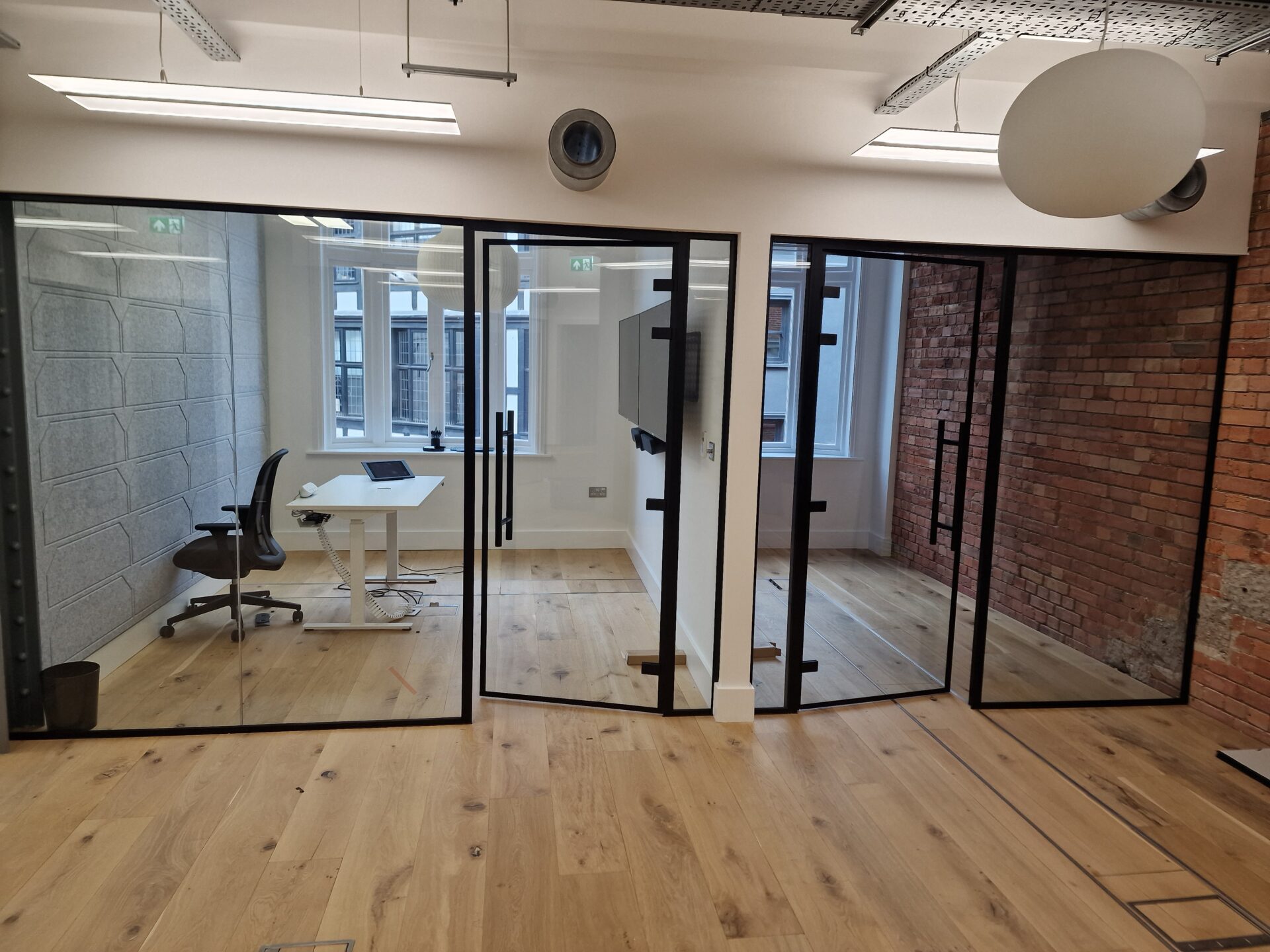
This article breaks down how tempered glass performs against sound, how it compares to acoustic glass and laminated glass, what options deliver true soundproofing for offices and commercial environments. By the end, you’ll know whether tempered glass alone is enough or if you’ll need specialized soundproof glass solutions for effective office soundproofing.
What Is Tempered Glass and How Is It Made?
Tempered glass, also known as toughened glass, is a type of safety glass engineered to be far stronger than standard annealed glass. The strength of tempered glass comes from its unique manufacturing process. Standard glass is first cut to size and polished, then heated in a furnace at around 600–700°C before being rapidly cooled with high-pressure air. This process, called quenching, locks tension into the outer surface while keeping the inner layers in compression.
The result is glass that is up to five times stronger than untreated glass and highly resistant to thermal stress, pressure, and impact. Instead of breaking into sharp, dangerous shards, it shatters into small, blunt fragments that reduce the risk of injury. Because of these properties, tempered glass is widely used in high-traffic commercial spaces, especially for doors, partitions, and windows.
Does Tempered Glass Reduce Noise?
Tempered glass provides excellent safety and durability, but it is not specifically designed to block sound. In spaces where noise control is essential; such as offices, healthcare facilities, or hospitality venues, tempered glass alone may not be sufficient. Its solid, single-pane structure allows vibrations and noise to pass through easily, offering only minimal acoustic insulation. While it can slightly dampen sound compared to standard annealed glass due to its increased thickness and rigidity, it cannot match the performance of specialized acoustic or laminated glass systems engineered for effective noise reduction.
Tempered vs. Regular Glass
| Feature | Tempered Glass | Regular (Annealed) Glass |
| Strength | Significantly stronger than regular glass | Standard strength, more prone to breakage |
| Safety | Shatters into small, blunt fragments | Breaks into sharp, dangerous shards |
| Thermal Resistance | High; withstands rapid temperature changes | Lower; can crack under thermal stress |
| Acoustic Performance | Minimal sound reduction | Slightly less than tempered due to lower rigidity |
| Typical Uses | Doors, partitions, and windows in commercial spaces | Windows, low-risk interior panels |
Note: Noise reduction is measured in STC ratings.
Factors That Affect Tempered Glass Soundproofing
1. Glass thickness: Thicker panels slightly reduce sound transmission compared to thinner ones.
2. Seal quality: Properly sealed frames and gaps prevent sound leakage around the glass edges.
3. Mounting and framing systems: The way glass is mounted or framed, especially in partitions, affects noise transfer.
4. Panel size and area: Larger uninterrupted glass panels can allow more sound to pass through unless combined with acoustic solutions.
5. Room layout: Open-plan layouts or reflective surfaces can amplify sound, reducing the effectiveness of tempered glass as a noise barrier.
6. Adjacent materials: Surrounding walls, floors, and ceilings influence how much noise enters or leaves a space.
Better Glass Options for Soundproofing
1. Laminated glass: Made of two or more glass layers bonded with a PVB interlayer, which significantly improves acoustics by reducing sound transmission while maintaining clarity and safety.
Related Read: What is Laminated Glass
2. Acoustic glass: Acoustic glasses are specifically engineered to block noise, often using thicker panels, multiple layers, or specialized interlayers for maximum sound insulation.
Explore: Acoustic Glass Partitions
3. Double-glazed glass: Double-glazed glass consists of two panes of glass separated by an air or gas-filled cavity can dramatically reduce noise, especially in offices or hospitality settings.
Explore: Double-Glazed Glass Partitions
4. Combination solutions: Laminated or acoustic glass can be paired with well-sealed frames, doors, and partitions to enhance overall soundproofing effectiveness.
Combining Tempered Glass with Other Noise-Control Methods
While tempered glass alone provides minimal soundproofing, its effectiveness can be enhanced when paired with additional noise-control measures:
1. Acoustic seals and gaskets: Adding specialized seals around frames and doors prevents sound leakage, improving overall noise reduction.
2. Layering tempered glass with laminated panes: Combining tempered glass with laminated glass increases thickness and introduces a PVB interlayer, which significantly dampens sound transmission.
3. Partition design strategies for offices: Thoughtful layouts, such as incorporating doors, ceiling panels, and additional acoustic partitions, can reduce noise transfer between rooms and create quieter, more productive spaces.
Where Tempered Glass Works Well And Where It Doesn’t
Works Well:
1. High-traffic areas: Doors, windows, and partitions in offices, retail spaces, and hospitality venues benefit from tempered glass’s strength and safety.
2. Safety-critical locations: Areas where breakage could cause injury, such as staircases, balustrades, and entrance doors.
3. Durable partitions: Ideal for spaces that require impact-resistant glass but do not need high-level acoustic insulation.
Where It Doesn’t:
1. Noise-sensitive spaces: Meeting rooms, recording studios, healthcare consultation rooms, or open-plan offices where controlling sound is essential.
2. Acoustic-critical areas: Environments that need specialized noise reduction, such as soundproof booths or rooms near busy streets.
Making the Right Choice for Your Commercial Space
Key considerations for businesses:
1. Budget: Determine the investment for glass partitions, doors, or windows based on material, size, and installation.
2. Safety: Choose tempered or laminated glass to meet building regulations and protect occupants in high-traffic areas.
3. Acoustic Needs: Assess whether standard tempered glass provides adequate noise reduction or if specialized acoustic or laminated glass is needed.
Final Thoughts
Tempered glass offers strength, safety, and durability, making it ideal for doors, partitions, and windows in commercial spaces. However, it provides only minimal sound reduction on its own. For effective noise control, combining tempered glass with laminated panes, acoustic seals, and strategic partition designs ensures privacy, comfort, and productivity. Choosing the right glass depends on balancing safety, aesthetics, and acoustic needs to create functional and inviting work or public environments.
FAQs
Yes, combining methods can improve both safety and noise control.
Thickness helps, but installation and framing matter more.
Not significantly, acoustic treatments are better for echo control.
Yes, films can slightly enhance acoustic performance.
Only in non-critical areas; laminated or acoustic glass is recommended.














